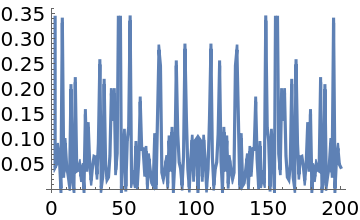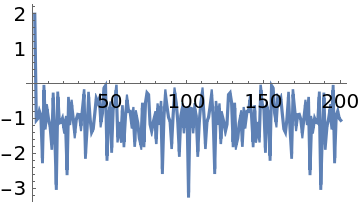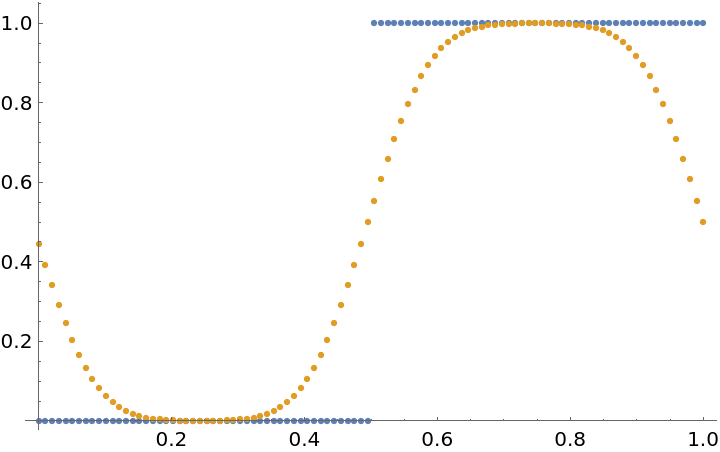Basic Examples (1)
Compute a discrete Hartley transform:
Scope (2)
x is a list of real values:
Compute the Hartley transform with machine arithmetic:
Compute using 24-digit precision arithmetic:
Compute a complex Hartley transform:
This is equivalent to separately taking the Hartley transforms of the real and imaginary parts:
Applications (2)
Use the discrete Hartley transform to compute the power spectrum of "white noise":
Show the logarithmic spectrum, including the first (DC) component:
Compute discrete cyclic convolutions to smooth a discontinuous function with a Gaussian:
Compute the cyclic convolution:
Show the original and smoothed function:
The convolution is consistent with ListConvolve:
Properties and Relations (4)
Compute the discrete Hartley transform from its definition:
DiscreteHartleyTransform is faster:
Compute the discrete Hartley transform of a vector by multiplying it with the Hartley matrix:
DiscreteHartleyTransform is faster:
The discrete Hartley transform is its own inverse:
A list of numbers:
Compute its discrete Hartley transform:
Use the discrete Hartley transform to compute the discrete Fourier transform:
Compare with the result of Fourier:



![dat = RandomReal[1, 200];
fht = ResourceFunction["DiscreteHartleyTransform"][dat];
ListLinePlot[(fht^2 + RotateRight[Reverse[fht]]^2)/2]](https://www.wolframcloud.com/obj/resourcesystem/images/a90/a901ffba-4567-4b6e-975a-98e5aa482ed7/1-0-0/49753d44854ad038.png)


![n = 100; dx = 1./(n - 1);
a = Table[UnitStep[x - 1/2], {x, 0, 1, dx}];
b = Table[
If[x <= 1/2, Exp[-100 x^2], Exp[-100 (1 - x)^2]], {x, 0, 1, dx}];
b = b/Total[b];](https://www.wolframcloud.com/obj/resourcesystem/images/a90/a901ffba-4567-4b6e-975a-98e5aa482ed7/1-0-0/33b825381e62b3c1.png)

![hta = ResourceFunction["DiscreteHartleyTransform"][a];
htb = ResourceFunction["DiscreteHartleyTransform"][b];
rb = RotateRight[Reverse[htb]];
c = Sqrt[
Length[a]] ResourceFunction["DiscreteHartleyTransform"][
hta (htb + rb) + RotateRight[Reverse[hta]] (htb - rb)]/2;](https://www.wolframcloud.com/obj/resourcesystem/images/a90/a901ffba-4567-4b6e-975a-98e5aa482ed7/1-0-0/76a6eb6e2adff308.png)

![AbsoluteTiming[v1 = Table[1/Sqrt[n] \!\(TraditionalForm\`
\*UnderoverscriptBox[\(\[Sum]\), \(r = 1\), \(n\)]\*
TemplateBox[{"u", "r"},
"IndexedDefault"]\ \((Cos[
\*FractionBox[\(2 \[Pi]\ \((r - 1)\)\ \((s - 1)\)\), \(n\)]] + Sin[
\*FractionBox[\(2 \[Pi]\ \((r - 1)\)\ \((s - 1)\)\), \(n\)]])\)\), {s, 1, n}]]](https://www.wolframcloud.com/obj/resourcesystem/images/a90/a901ffba-4567-4b6e-975a-98e5aa482ed7/1-0-0/2aed5420bc1f1da0.png)

